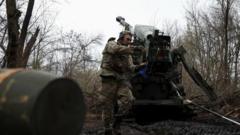
Fragile Peace: 30-Hour Easter Truce Marred by Reported Violations
The recently implemented 30-hour "Easter truce," intended to provide a temporary respite from ongoing hostilities, has been plagued by reports of violations, highlighting the immense challenges in achieving even brief periods of ceasefire in the current conflict. The limited success of this truce underscores the deeply entrenched animosity and complexities hindering sustained peace efforts.
Initial Hopes and Expectations
The declaration of the Easter truce was initially met with cautious optimism. Many hoped that the significance of the religious holiday would encourage all parties involved to adhere to the agreement, allowing civilians to observe Easter peacefully and providing an opportunity for humanitarian aid to reach those in need. Furthermore, it was envisioned as a potential stepping stone towards broader and more lasting ceasefires.
The specific goals of the truce, as articulated by various negotiating parties, included:
- Allowing civilians safe passage to observe Easter services.
- Facilitating the delivery of essential humanitarian aid, including food, water, and medical supplies.
- Providing a period of quiet for repairs to critical infrastructure, such as power grids and water systems.
- Building trust between conflicting parties, paving the way for future negotiations.
Reports of Violations Emerge
Despite these hopes, reports of violations began to surface within hours of the truce taking effect. These reports, gathered from various sources including local residents, independent journalists, and international monitoring organizations, painted a concerning picture of continued conflict activity.
Types of violations reported included:
- Sporadic artillery fire in contested territories.
- Small-arms exchanges between opposing forces.
- Continued aerial reconnaissance activities.
- Allegations of troop movements and repositioning.
Challenges in Verifying Violations
Verifying these reports presented significant challenges. The volatile security situation made it difficult for independent observers to access conflict zones and gather reliable information. Furthermore, conflicting parties often presented differing accounts of events, making it challenging to determine the veracity of claims and counterclaims. The lack of a neutral and empowered monitoring force on the ground further compounded the problem.
Impact on Humanitarian Efforts
The reported violations had a significant impact on humanitarian efforts. Aid organizations were forced to suspend or curtail their operations in areas affected by the fighting, hindering the delivery of critical assistance to vulnerable populations. The continued insecurity also prevented civilians from safely accessing essential services, such as medical care and food distribution centers.
Underlying Factors Contributing to the Instability
Several underlying factors contributed to the instability and the eventual violations of the truce. These factors include:
- Deep-seated mistrust between conflicting parties.
- The presence of multiple armed groups with differing agendas.
- The influence of external actors with competing interests.
- The limited capacity of local authorities to enforce the ceasefire.
- Breakdowns in communication channels between opposing commanders.
The Future of Peace Negotiations
The failure of the Easter truce raises serious questions about the future of peace negotiations. While the brief ceasefire demonstrated a willingness to engage in dialogue, the subsequent violations highlight the significant challenges in building trust and achieving sustained stability. It is crucial that international mediators and diplomatic efforts continue to engage with all parties involved, focusing on confidence-building measures, clear communication channels, and robust monitoring mechanisms to ensure that any future ceasefire agreements are effectively implemented and respected. Furthermore, addressing the root causes of the conflict is paramount to achieving a lasting peace.
Ultimately, the path towards a peaceful resolution will require a genuine commitment from all parties involved to prioritize dialogue, compromise, and the well-being of the civilian population.
```